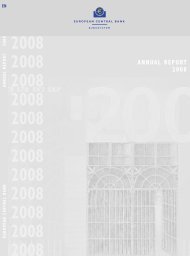Reserve Bank of Australia Annual Report 2011
Reserve Bank of Australia Annual Report 2011
Reserve Bank of Australia Annual Report 2011
You also want an ePaper? Increase the reach of your titles
YUMPU automatically turns print PDFs into web optimized ePapers that Google loves.
Staff in the State Offices also play a role in the <strong>Reserve</strong> <strong>Bank</strong>’s efforts to keep the public informed <strong>of</strong> its evolving<br />
views on the economy. They interact with a broad cross-section <strong>of</strong> the community, regularly giving<br />
presentations on economic developments to business groups, community organisations and educational<br />
institutions, in both state capitals and regional centres. They also facilitate regular visits by senior staff from<br />
Head Office’s Economic Group to meet with liaison contacts and provide briefings on the economy. Staff from<br />
the State Offices also visit Tasmania and the Northern Territory to gather information on economic conditions<br />
in those regions.<br />
Liaison with Small Businesses<br />
The <strong>Reserve</strong> <strong>Bank</strong> continues to convene its Small Business Advisory Panel. This Panel was established in 1993<br />
and meets annually to discuss issues relating to the provision <strong>of</strong> finance and the broader economic environment<br />
for small businesses. Membership <strong>of</strong> the Panel is drawn from a range <strong>of</strong> industries across the country. The Panel<br />
represents a valuable source <strong>of</strong> information on the financial and economic conditions faced by small businesses.<br />
The <strong>Bank</strong>’s business liaison program also involves <strong>Bank</strong> staff meeting with a number <strong>of</strong> small businesses and<br />
small business groups.<br />
Museum <strong>of</strong> <strong>Australia</strong>n Currency Notes<br />
The <strong>Reserve</strong> <strong>Bank</strong>’s Museum contains a permanent collection and also hosts periodic exhibitions. The<br />
permanent collection exhibits the story <strong>of</strong> <strong>Australia</strong>’s banknotes against the backdrop <strong>of</strong> the nation’s broader<br />
social and economic history. It displays the types <strong>of</strong> money used before Federation – from an early colonial rum<br />
bottle through to <strong>Australia</strong>’s first gold coins. Visitors can then view various banknotes produced since the first<br />
<strong>Australia</strong>n note series in 1913–1915. Finally, the Museum focuses on <strong>Australia</strong>’s polymer banknotes, describing<br />
their design, security features and potential for recycling. When viewing the collection, visitors can observe the<br />
evolution <strong>of</strong> <strong>Australia</strong>n identity as expressed through the nation’s currency, learn about the influential men and<br />
women depicted on the banknotes and the artwork used in banknote design.<br />
Some temporary exhibitions held during the second half <strong>of</strong> the financial year were a legacy <strong>of</strong> the<br />
<strong>Reserve</strong> <strong>Bank</strong>’s 50th anniversary celebrations. One exhibition, ‘Hidden History <strong>of</strong> <strong>Bank</strong>ing’, displayed convict<br />
banking records and was used to show the progress <strong>of</strong> convicts to citizens whose contribution to society<br />
resulted in them being represented on the nation’s banknotes. Another exhibition, ‘Reflections <strong>of</strong> Martin Place’,<br />
included historic photographs from the <strong>Bank</strong>’s collection <strong>of</strong> landmark financial events in Martin Place, with<br />
these photographs displayed on the façade <strong>of</strong> the Head Office building. And there was a display <strong>of</strong> the early<br />
artworks and interior design commissioned by the <strong>Bank</strong>’s first Governor, HC (‘Nugget’) Coombs, who was<br />
committed to modernism and progress.<br />
Around 13 500 people visited the Museum in 2010/11, including over 1 300 visitors on <strong>Australia</strong> Day <strong>2011</strong>.<br />
Attendance was also boosted by the <strong>Reserve</strong> <strong>Bank</strong>’s participation in History Week and its collaboration with<br />
other museums in the city precinct through ‘The History Trail’ schools program. A wide cross-section <strong>of</strong> the<br />
public visit the Museum, including school groups. Many school groups receive a short presentation on the role<br />
<strong>of</strong> the <strong>Reserve</strong> <strong>Bank</strong> or, in the case <strong>of</strong> senior economics students, a talk on the <strong>Australia</strong>n economy. Increasingly,<br />
the Museum is hosting primary school groups, with these students receiving presentations on the role <strong>of</strong><br />
money and the features <strong>of</strong> <strong>Australia</strong>n banknotes. During the year, the Museum was also visited by groups <strong>of</strong><br />
new migrants learning about the nation’s currency. Most <strong>of</strong> the information in the Museum is on the <strong>Bank</strong>’s<br />
website. There were around 750 000 page views/downloads <strong>of</strong> information from the Museum site in the past<br />
year, up significantly from levels <strong>of</strong> recent years; the site is visited in roughly equal numbers by domestic and<br />
overseas users, with the level <strong>of</strong> overseas interest increasing in recent years.<br />
44 <strong>Reserve</strong> bank <strong>of</strong> <strong>Australia</strong>





![KNOW YOUR NEW GIBRALTAR BANKNOTES - [Home] bThe/b](https://img.yumpu.com/50890985/1/184x260/know-your-new-gibraltar-banknotes-home-bthe-b.jpg?quality=85)
![PAPUA NEW GUINEA - [Home] - Polymer Bank Notes of the World](https://img.yumpu.com/49758743/1/190x143/papua-new-guinea-home-polymer-bank-notes-of-the-world.jpg?quality=85)










